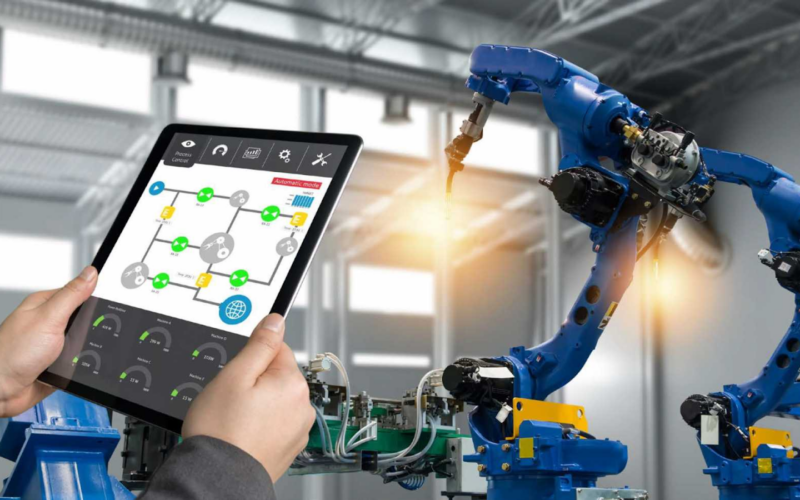Manufacturing automation is the coordinated use of machines, control systems, robotics, AI, analytics, and industrial IoT to run production with less variability and greater control. It connects equipment and data so plants can increase throughput, maintain tight tolerances, reduce scrap, and switch products with less disruption.
The payoff is real. Recent research shows unplanned downtime now eats about 11 percent of revenue for the largest manufacturers, or roughly 1.4 trillion dollars a year.
This blog explains the core types of automation, the benefits leaders track, why machine monitoring is the first step, the key tools from CNC to PLCs, and what is coming next.
Key Takeaways
- Manufacturing automation uses machines, control systems, AI, and IoT to increase throughput, improve quality, and reduce downtime.
- Enterprises are automating to lower costs, improve scalability, and maintain consistent quality across global operations.
- Automation types include fixed, programmable, flexible, and integrated systems, each suited to different production needs.
- Machine monitoring is the first step, as it helps identify inefficiencies, reduce downtime, and quantify the ROI of automation.
- Key tools include CNC, PLCs, AI, and IoT, all of which help optimize production, predictive maintenance, and quality control.
Why are Enterprises Automating Manufacturing?
Manufacturing leaders are under pressure to meet unpredictable demand, maintain margins, and maintain consistent quality across global plants. Many are turning to automation as a strategic investment rather than a cost decision.
The global market for industrial automation is projected to reach 307.7 billion USD by 2030, growing at more than 9 percent annually, a clear signal that automation is now central to enterprise operations, not a side initiative. For large manufacturers, it is the foundation for stable output, predictable costs, and long-term resilience.
1. Lower Cost per Unit and Faster Time-to-Market
Large manufacturers are under pressure to reduce the cost per part while bringing products out faster. Automating repetitive production steps reduces labor variability, optimizes machine utilization, and shortens cycle time.
With automated setups, companies can respond to demand shifts without large increases in overhead.
2. Global Competitiveness and Scale Operations
Enterprise manufacturers operate across geographies. Automation allows for consistent production standards across sites and supports global supply chains.
Automation also attracts investment: the U.S. manufacturing sector’s share of foreign direct investment is strongly tied to factory automation levels.
3. Higher Yields and Improved Consistency
When machines replace manual hand-offs and human variability, defect rates drop and quality stabilizes. For example, automating inspection and process checks enables faster fault detection and significantly fewer scrap parts.
4. Enabling Digital Transformation and Sustainability
Automated systems generate continuous data streams on performance, energy use, and material flow. This visibility enables predictive maintenance, leaner production, and better resource utilization. Many enterprises use this data to meet sustainability metrics, reduce waste, and improve profitability.
Is your connected ecosystem ready for the next leap? At Codewave, we build IoT and Edge AI solutions that think, adapt, and perform in real time. From device strategy to secure, scalable app development, we help you turn continuous data into continuous value.
Also Read: Top 10 AI Applications Across Major Industries
Furthermore, understanding the different types of automation can help businesses decide which system suits their production needs and objectives.
Key Types of Automation in Manufacturing
Manufacturing automation falls into four buckets. Fixed, programmable, flexible, and fully integrated systems. Each type answers a different mix of volume, variety, and changeover needs. The right choice depends on product stability, required throughput, and how often you change SKUs.
1. Fixed automation
Fixed automation executes a preset sequence at very high speed. The hardware defines the process. Reconfiguration is difficult and costly.
Characteristics
- Mechanisms such as cams, gears, and dedicated wiring encode the sequence.
- Best for stable products with very high demand.
- High initial tooling and line cost. Unit cost falls with scale.
Enterprise use cases
- Automotive body and paint lines.
- Beverage filling and packaging.
- Consumer electronics assembly where designs remain stable across long runs.
- Typical output ranges in the hundreds to thousands of units per hour.
Limitations and risks
- Limited flexibility. Any design change can require major retooling.
- High sunk cost. Risk rises when product mix or demand shifts.
- Long commissioning windows before the first good part.
2. Programmable automation
Programmable automation runs batches. Equipment can be reprogrammed between runs to make different products. Changeovers require planned setup work
Characteristics
- Control logic is software-based. Programs can be switched to produce variants.
- Suits medium volumes and seasonal demand.
- Changeovers include tool changes, fixture swaps, and parameter updates.
Enterprise use cases
- Batch production of valves, pumps, and industrial components.
- Electronics where variants share common platforms.
- Food and personal care lines with frequent recipe switches.
- Suitable where product families share tooling but differ in features.
Changeover considerations
Use SMED (Single-Minute Exchange of Dies), a lean manufacturing method developed by Shigeo Shingo, to reduce setup time and increase asset availability. Peer-reviewed studies report a 30 % or more reduction in changeover time within a year. Other case work shows several-minute cuts per changeover with lower operator burden.
3. Flexible automation
Flexible automation supports rapid product switches with minimal manual setup. Programs, fixtures, and routing adapt quickly. Connectivity and centralized control are standard.
Characteristics
- Multi-purpose equipment, such as industrial robots and advanced CNC.
- Short changeover windows and dynamic scheduling.
- Often tied to MES, quality systems, and advanced sensing.
Enterprise use cases
- Mixed model assembly in automotive and heavy equipment.
- High mix machining cells with automated pallet systems.
- Contract manufacturing that serves many SKUs each day.
- Examples include robot cells that switch between drilling, fastening, sanding, coating, or welding.
Why it matters
- Better asset utilization in plants with volatile demand.
- Supports late-stage customization without extended downtime.
- Complements SMED to compress setup time further. Documented programs show material reductions in changeover time with sustained quality gains.
4. Integrated automation or smart factory
Integrated automation connects machines, sensors, and software across the plant. Data moves in real time from edge devices to control and planning layers. The system detects anomalies, schedules maintenance, and synchronizes lines.
Core elements
- Unified network of PLCs, robots, quality systems, and industrial IoT.
- Central monitoring with actionable alerts and role-based dashboards.
- Data models that link work orders, parameters, and outcomes.
Enterprise use cases
- Multi-site manufacturers that need common standards and remote visibility.
- Predictive maintenance programs that cut unplanned stops through condition data.
- Energy and carbon tracking tied to operations for compliance and cost control.
Key stats that show scale
- The average global robot density reached 162 robots per 10,000 manufacturing employees in 2023. Asia and the European Union continued to rise, reflecting deeper integration of automated cells.
- The global installed stock of industrial robots reached about 4.66 million units in 2024.
Before diving into full-scale automation, it’s crucial to understand and monitor machine health to maximize efficiency.
What is Machine Monitoring and Why Is It Your First Step?
Machine monitoring is the continuous capture and analysis of equipment data to see utilization, downtime, performance, and asset health in one place. It comes first because it exposes where losses occur, quantifies the business case for automation, and sequences fixes by impact.
Predictive maintenance programs that build on this data have been shown to cut machine downtime by 30–50% and extend machine life by 20–40%, which is only possible when reliable condition data exists.
What machine monitoring captures
You need a clear scope before listing what to measure.
- Utilization: Runtime, idle time, changeover time, OEE components.
- Downtime: Unplanned stops, reasons, duration, restart time.
- Performance: Cycle time, throughput, takt adherence, quality yield.
- Health: Temperature, vibration, current draw, lubrication, tool wear.
Why it pays off
Use the numbers to drive specific actions.
- Downtime tracking: Find chronic stops, validate root causes, prioritize maintenance.
- Utilization reporting: Expose underused assets, balance lines, right-size capacity.
- Early fault detection: Flag drift on health indicators and schedule interventions.
How to evaluate machine health
Select the appropriate inputs before assessing machine health.
- Metrics: MTBF, MTTR, defect rate, SPC limits, energy per unit.
- Sensors: Vibration, acoustic, thermal, power, pressure, flow, oil particles.
- Analytics: Threshold rules, anomaly detection, failure mode models, PdM.
- Dashboards: Cell-to-plant views, alerts by role, drill-down from shift to event.
Implementation of quick wins
Start small and standardize as you scale.
- Start with a pilot cell that represents common failure modes.
- Standardize downtime reason codes and clock accuracy.
- Instrument critical assets first, then expand by failure cost.
- Close the loop with daily reviews and a weekly action log.
Only 16% of manufacturers see work in progress in real time across the process. Without that baseline, automation becomes guesswork and capital goes to the wrong problems.Put monitoring in place first to surface losses as they occur. Then automate where the data shows the fastest payback.
Is Your Data Telling You the Truth or Just More Noise?
At Codewave, we help you turn scattered information into clarity that drives bold, confident decisions. Our Data & AI strategy services transform raw data into real advantage, cutting manual work, improving access, and making every metric count.
Now let’s explore the tools and methodologies that enable manufacturing automation, from CNC machines to AI-driven systems.
What Tools and Methodologies Power Manufacturing Automation?
Manufacturing automation runs on a stack of control methods and software. Each layer turns product intent into repeatable machine actions, closes feedback loops, and lifts throughput and quality.
| Tool / Method | Core Function | Typical Use |
| Numerical Control (NC) | Computer control of machine tools using fixed programs. | Simple milling, drilling, or turning operations with stable part geometry. |
| Computer Numerical Control (CNC) | Embedded software controls multi-axis tool motion with programmable paths. | Complex machining with frequent design updates or precision requirements. |
| Automated Tools | Software-driven machinery such as robotic arms and automated guided vehicles (AGVs). | Material handling, assembly, inspection, and part transfer between stations. |
| Computer-Aided Design (CAD) | Digital design and modeling of components and fixtures. | Product design optimization, tolerance analysis, and simulation before production. |
| Computer-Aided Manufacturing (CAM) | Converts CAD models into toolpaths and machining instructions. | CNC programming, toolpath optimization, and scrap reduction. |
| Programmable Logic Controllers (PLCs) | Controls machine logic, sensors, and actuators in real time. | Equipment sequencing, safety control, and process interlocks. |
| IoT and Edge Computing | Collects, processes, and transmits equipment data from sensors near the source. | Machine monitoring, OEE tracking, and predictive maintenance. |
| Robotics | Executes repetitive or precision tasks through programmed motion. | Welding, fastening, palletizing, and visual inspection. |
| AI and Machine Learning | Identifies patterns and predicts failures from large process datasets. | Predictive maintenance, adaptive process control, and quality inspection. |
As we look at the tools and methodologies, the future of manufacturing is moving toward fully integrated systems that can learn, adapt, and operate autonomously across the entire production floor.
Looking Forward: The Future Of Manufacturing Automation
Plants are moving from standalone cells to connected systems that plan, execute, and learn across the entire line. Robots handle repeatable tasks, AI tunes schedules and detects drift, and IoT streams machine, quality, and energy data into a single model.
Supervisors shift from operating stations to setting constraints, confirming actions, and resolving exceptions.
How Close Are We To Fully Automated Factories
Lights-out operation is already viable in stable, narrow flows such as machining cells, palletizing, and pack out. End-to-end autonomy needs reliable inline inspection, deterministic material movement, and proven recipes across shifts. Asia installed about 70% of new industrial robots in 2023, concentrating the conditions where unattended islands scale first.
How People, Machine Learning, And AI Will Work Together
Human roles move from direct operation to exception handling, constraint setting, and continuous improvement. AI schedules jobs, predicts failures, and verifies quality while supervisors confirm actions and adjust limits. In McKinsey’s latest survey, 78% of organizations report using AI in at least one business function, which aligns with a near-term hybrid workforce on the plant floor.
What Advances To Expect In Robotics And IoT
Cobots expand into fastening, inspection, and kitting, while mobile robots close gaps between machining, test, and pack. Edge devices stream cycle, energy, and condition data with low latency, thereby tightening control loops.
Why Cost And Payback Are Improving
Standard robot platforms, modular end effectors, and off-the-shelf vision systems shorten integration time. Edge computing reduces backhaul and normalizes tags near the process, reducing the cost of connecting legacy equipment.
IDC projects global edge spending approaching $380 billion by 2028, supporting plant-wide data capture and closed-loop control
How We at Codewave Support Enterprise-Scale Manufacturing Automation
At Codewave, we enable enterprise manufacturers to transform legacy operations into connected, data-driven systems that scale across geographies. Our approach combines design-thinking, automation expertise, and real-time data integration.
- Assessment and Roadmap: We run design thinking workshops to align goals, map value streams, and set OKRs with a clear rollout plan.
- Data And IoT Foundation: We connect machines and sensors, define a common data model, and stream telemetry to the cloud or edge for reliable monitoring.
- AI and Analytics Execution: We build ML models for quality, maintenance, and scheduling, and integrate them into existing systems for action, not just dashboards.
- Human Machine Experience: We design operator and supervisor interfaces that speed adoption and reduce training time across sites.
- Scale And Governance: We template code, models, and UI patterns so programs can be cloned across plants with consistent metrics and controls.
Explore our portfolio to see how we’ve helped enterprises modernize production, improve efficiency, and accelerate data-driven decision-making.
Conclusion
Connected systems, real-time decision loops, and human-machine collaboration define manufacturing in 2025. Enterprises are moving from isolated automation pilots to unified ecosystems where every asset produces data and every process can adapt. Success now depends on how quickly a company can turn that data into faster throughput, higher yield, and lower cost per unit.
At Codewave, we help enterprise manufacturers design, scale, and integrate automation that drives measurable results, from plant-floor connectivity to AI-driven analytics.
Start your automation journey with us today.
FAQs
Q: What are the benefits of machine monitoring in manufacturing automation?
A: Machine monitoring captures real-time data on equipment performance, downtime, and health. It helps identify inefficiencies and reduces unplanned downtime. By tracking asset utilization and condition, manufacturers can improve asset longevity and reduce overall operational costs.
Q: How can automation help with global competitiveness in manufacturing?
A: Automation ensures consistent production quality and standards across multiple sites, which is essential for managing global supply chains. By streamlining processes, it supports scalability and makes enterprises more attractive for investment, especially in industries like automotive and electronics.
Q: What role does AI play in manufacturing automation?
A: AI enhances manufacturing automation by enabling predictive maintenance, adaptive scheduling, and quality inspections. AI algorithms learn from data to predict failures and optimize production processes, leading to higher efficiency and fewer operational disruptions.
Q: What are the challenges of implementing fixed automation systems?
A: Fixed automation requires high initial investment and is inflexible when there are design changes or shifts in demand. Reconfiguring these systems can be costly, and product variability might be limited, which can pose a risk if the product mix changes.
Q: How does machine learning contribute to predictive maintenance in manufacturing?
A: Machine learning models analyze historical data from machines and sensors to predict when equipment is likely to fail. This allows manufacturers to schedule maintenance proactively, reducing unexpected downtime and extending machinery’s lifespan.
Codewave is a UX first design thinking & digital transformation services company, designing & engineering innovative mobile apps, cloud, & edge solutions.







